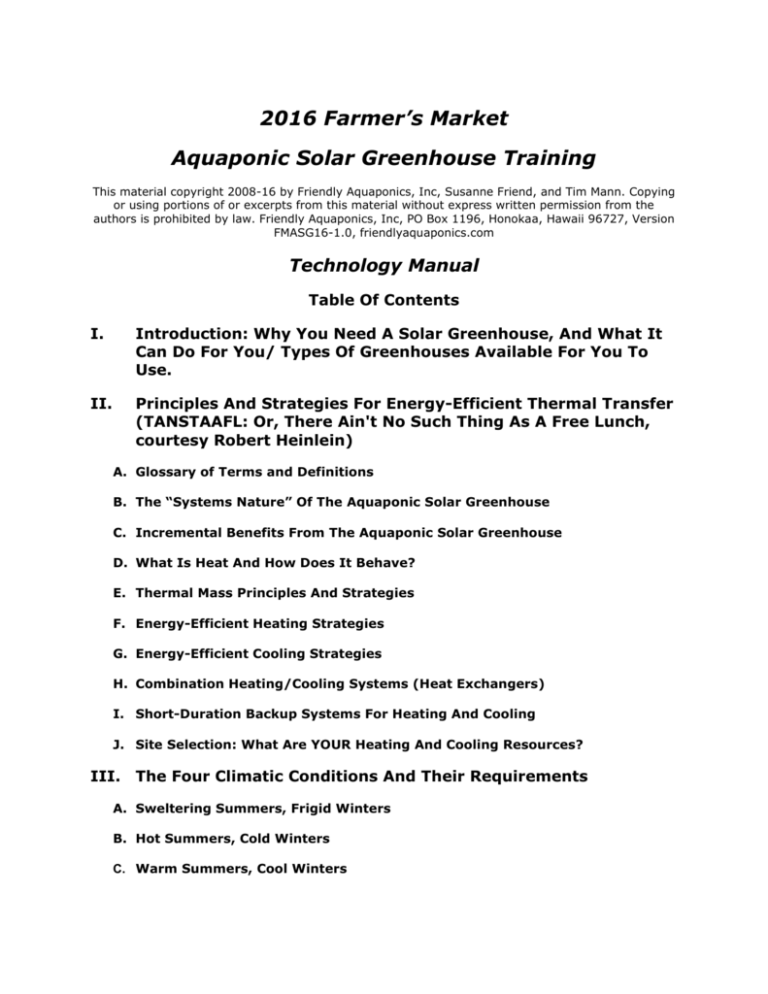Aquaponic Solar Greenhouse Training
advertisement

2016 Farmer’s Market Aquaponic Solar Greenhouse Training This material copyright 2008-16 by Friendly Aquaponics, Inc, Susanne Friend, and Tim Mann. Copying or using portions of or excerpts from this material without express written permission from the authors is prohibited by law. Friendly Aquaponics, Inc, PO Box 1196, Honokaa, Hawaii 96727, Version FMASG16-1.0, friendlyaquaponics.com Technology Manual Table Of Contents I. Introduction: Why You Need A Solar Greenhouse, And What It Can Do For You/ Types Of Greenhouses Available For You To Use. II. Principles And Strategies For Energy-Efficient Thermal Transfer (TANSTAAFL: Or, There Ain't No Such Thing As A Free Lunch, courtesy Robert Heinlein) A. Glossary of Terms and Definitions B. The “Systems Nature” Of The Aquaponic Solar Greenhouse C. Incremental Benefits From The Aquaponic Solar Greenhouse D. What Is Heat And How Does It Behave? E. Thermal Mass Principles And Strategies F. Energy-Efficient Heating Strategies G. Energy-Efficient Cooling Strategies H. Combination Heating/Cooling Systems (Heat Exchangers) I. Short-Duration Backup Systems For Heating And Cooling J. Site Selection: What Are YOUR Heating And Cooling Resources? III. The Four Climatic Conditions And Their Requirements A. Sweltering Summers, Frigid Winters B. Hot Summers, Cold Winters C. Warm Summers, Cool Winters D. Warm Summers, Warm Winters (Tropical/SubTropical) IV. Tactics For Addressing The Four Conditions A. Glazing Methods And Considerations 1. 2. 3. 4. 5. ETFE Film Glazing Standard Poly Film Glazing Double-Layer Inflated Poly Film Glazing Polycarbonate Rigid Sheet Glazing Glass Glazing: Single And Double Layer B. Insulation 1. 2. 3. 4. 5. How Insulation Works; Types Of Insulation Insulating The Aquaponics System Water Containers Insulating The Greenhouse Walls Insulating The Greenhouse Roof (Glazing/Insulated Glazing) Insulating The Greenhouse Floor C. Energy-Efficient Cooling Methods 1. 2. 3. 4. 5. 6. 7. 8. Passive Hot Air Venting Active Hot Air Venting Active Air Cooling Cooling The Aquaponics System Water Using Geothermal Water Heat Exchangers Cooling The Greenhouse Air Using Geothermal Air Heat Exchangers Cooling The Greenhouse Air Using Water Walls/Swamp Coolers Cooling The Greenhouse Using Shading Methods Backup Cooling Methods For The Solar Greenhouse D. Energy-Efficient Heating Methods 1. Heating the Aquaponics System Water Using Solar Water Heat Exchangers 2. Heating The Greenhouse Air Using Solar Air Heat Exchangers 3. Actively Heating The Aquaponics System Water/Backup Heating System (Burning Something For Heat) 4. Actively Heating The Greenhouse Air/Backup Heating System (Burning Something For Heat) E. Combination Heating/Cooling/Electricity Production Systems 1. Rare Circumstances: Unlimited Wind, Hydro, or Natural Gas On-Site V. Electrical Use, Conservation, And Generation A. Electricity: What It Is And How It Works 1. 2. 3. 4. 5. How Electricity Works: AC And DC And Alternate Energy How To Design Your System For Your Electrical Needs The AC System The DC System Safety Precautions: If You Have Any Doubts, GET AN ELECTRICIAN! B. Methods For Conservation Of Electricity 1. 2. 3. 4. How To Choose Electrically-Efficient Equipment Timers, Programmable Timers, And Other Electrical Control Equipment Backup Electrical Power Issues Partial Operation: Winter Configuration/Summer Configuration C. Generating Electricity: Alternate Energy Systems 1. 2. 3. 4. 5. 6. The Easiest Way: Use The Grid (If You Can) Small Hydro-Electric Systems Electric Wind Turbines PhotoVoltaic Panels (PV) Biogas-Powered Electricity Generation Internal Combustion Backup Generators A modern Chinese Solar Greenhouse. Although they are growing in the dirt and in pots inside the greenhouse, this structure gives many of the benefits our Aquaponic Solar Greenhouse does. Note the concrete grade beam to the left that the ends of the steel trusses that form the roof of this greenhouse are embedded into. Concrete and the labor to form it is quite inexpensive in China. Also note the North wall to the right that the trusses also attach to: this wall is often up to four feet thick, with double layers of masonry brick with straw bales in between for insulation. NOT a construction method that most US Building Departments currently allow. China is building thousands more of these right now, as they allow farmers to grow warm-weather crops such as tomatoes and cucumbers right through the often-severe Chinese winters. Construction Manual A. General Information page 49 B. Insulation In Depth 1. 2. 3. 4. Insulating Insulating Insulating Insulating The The The The Aquaponics System Water Containers Greenhouse Walls Greenhouse Roof (Glazing, Thermal Kilt) Greenhouse Floor C. Ventilation In Depth 1. Passive Summertime Ventilation Through Ridge Vent 2. Passive/Active Summertime Ventilation Through Vents And Doors 3. Wintertime Venting D. Introduction To The Chinese-Style Greenhouse: Choosing The Right Kind E. Modular Chinese Greenhouse 1. 2. 3. 4. 5. 6. 7. 8. Pros And Cons Site Prep, Foundation, And Foundation Insulation Panel Construction Techniques And Materials Curved Beam Construction Techniques And Materials Moving And Storing Panels Erecting Panels And Assembling Modules Finishing The Greenhouse The Seeding, Germination, And Harvesting Area F. Built-In-Place Chinese Greenhouse 1. 2. 3. 4. Pros And Cons Site Prep And Foundation Wooden Stud Construction Steel Stud Construction G. Steel-Framed Conventional Greenhouses 1. 2. 3. 4. Pros And Cons What To Include In Your Purchase Erection Of New “Conventional” Greenhouses Disassembly, Transportation, and Erection Of Used Greenhouses H. Other Types Of Greenhouses 1. Wood-Framed Greenhouses I. Construction Photos Epoxy Technology For Building Laminated Wooden Beams








